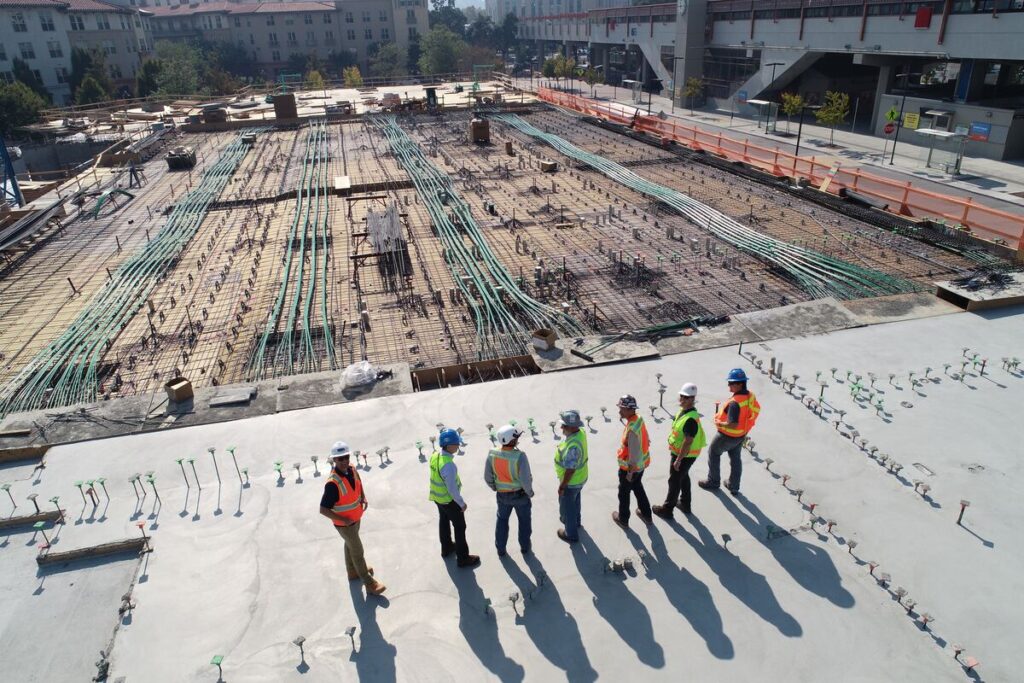Exclusive Neuroject Article: Many firms struggle with project overruns regularly. This generally happens as a result of those last-minute improvements and mistake fixes that frequently take longer than expected. When projects that were on schedule suddenly go over budget, you end up losing a lot of money and dealing with your client’s irritated face often.
Construction scheduling is crucial to its success, and the construction timetable stands out as a key tool. Dodge discovered that 24% of the top projects finished ahead of schedule compared to just 6% of usual projects and 46% of the best projects finished under budget compared to only 10% of typical projects in terms of schedule and cost performance, which owners cite as being most useful. Unbelievably, 49% of usual projects went over budget and 61% of typical projects concluded late.
Construction scheduling streamlines labor management and anticipates demand, enabling larger projects and backlog growth. It eliminates guesswork by adapting to real-time site changes. Well-organized action scheduling enhances resource management, saving time and costs, and preemptively addressing issues. Detailed schedules benefit all parties, including clients, suppliers, and contractors, by clarifying project requirements.
Construction schedules combine all suggested components, including the scope of work, to preserve design integrity and produce an all-encompassing and effective strategy. It is important to design the schedule to maximize each contractor’s or subcontractor’s productivity.
In the sections that follow, we’ll go over the fundamentals of construction scheduling as well as the guidelines for creating a sound schedule, various construction scheduling methodologies and approaches, typical difficulties that schedules encounter, and solutions to these difficulties.
Table of Contents
What is Construction Scheduling?
Have you been construction scheduling projects for a while and are you worn out? Are the numerous deadlines, duties, and responsibilities that come with each project making you feel overburdened? If so, it’s time to alter your behavior!
Imagine having a road map that will lead you from the beginning to the end of the construction scheduling procedure. Imagine being able to manage numerous projects with the appropriate tools, strategies, and procedures. This manual will bring you to a setting where building projects are managed successfully and smoothly.
“The Ultimate Guide to Construction Scheduling in 2024” isn’t the typical guide. It’s a comprehensive and modern guide that will help you do every construction scheduling task without difficulty and with confidence. We have researched the subject and gathered the best methods, advice, and equipment used by the most skilled project managers in this industry. We’re now giving these to you! If you’re looking to change the way you manage your project management skills get ready to begin!
The planning, coordinating, and carrying out of projects are all under the control of construction scheduling. Defining project goals, developing a thorough strategy, putting together a qualified team, and managing operations like procurement, scheduling, and risk are all part of this process.
Along with technical construction expertise, it’s critical to have leadership, planning, and problem-solving abilities if you work in the construction sector. Delivering effective projects that satisfy client needs while reducing risks and assuring satisfaction is the ultimate objective.
The Process of Construction Scheduling
Are you willing to grasp the process and decipher the enigmas of managing building projects? So, buckle up as we walk you through the most crucial steps to successfully managing the construction schedule!
Let’s first explain what we mean when we talk about “construction scheduling.” It is only the action of overseeing a construction project from inception to completion. Establishing project targets and goals, creating schedules and plans, assigning roles and duties, and ensuring that everything is going smoothly and on schedule are all part of it.
But how do you get started? Setting the project’s scope is the first step in the process of construction scheduling. By doing this, the project’s boundaries and scope are established. The next step is to decide on the aims and objectives of your project. These will be useful to you, the team, and the project throughout.
Create an action plan and a timetable right away. Setting deadlines for each of the achievable, lesser tasks entails doing this. It’s important to be realistic about your timeline, so make sure you take any risks and potential issues into consideration.
Determine the roles and duties at this point. This entails determining who will be responsible for each task and ensuring that everyone is on an equal footing. Clear communication and teamwork are crucial for ensuring that everyone is aware of what is expected of them and what they can do to support the project’s success.
What does it take for effective construction scheduling in 2024?
To maximize return, managing construction scheduling requires a blend of the appropriate resources that are brought in at the appropriate moment. Project plans, people, and tools are three components that must be present in this mixture.
A well-thought-out project plan serves as the foundation for any successful project. This plan explains each step necessary for a project to be successful, from project conception and planning to execution and closeout.

Main Points of Construction Scheduling
- The first step for effective construction scheduling in the construction industry is to establish defined goals and objectives.
- For the project to go smoothly, team members and stakeholders must communicate and collaborate effectively.
- The building site needs to be efficiently run with a focus on safety, tracking progress, and problem-solving.
- The effectiveness and precision of construction scheduling can be considerably increased by implementing technology and using data analytics.
- The keys to successfully managing construction scheduling in 2024 and beyond are planning, communication, technology, and constant improvement.
Essential Tools and Technologies for Construction Scheduling
Are you tired of juggling a lot of activities while attempting to meet deadlines and fulfill obligations in the construction sector? Utilizing the proper technologies and tools will help you move things along right away! Construction scheduling can be a difficult and intimidating undertaking, but employing the right tools and technology can help you streamline your procedure and make managing your projects simple.
You must have the following essential tools and technology in your toolbox to manage construction scheduling:
Software: The software provides a central hub for managing tasks and projects, monitoring development, and coordinating with team members. It is an essential tool for staying informed and current. When it comes to construction scheduling management software, utilizing Ezelogs is a no-brainer. It’s an intuitive platform with lots of functionality that makes managing your projects simple.
You can develop and maintain a construction schedule with the help of the software. It will assist you in staying on top of deadlines and progress, ensuring that everything goes according to plan and on the construction schedule. A robust construction scheduling tool is also included with Ezelogs to assist you in easily managing and creating schedules.
Collaboration Instruments: Any job requires teamwork to be completed successfully, and the appropriate tools will enable you to work efficiently with your coworkers. There are many ways to stay in touch and on the correct track, in addition to online meetings and file-sharing services. You’ll have all the tools you need in one place with Ezelogs to collaborate and communicate with your team.
Tools for Budgeting and Cost Control: Costly projects are sometimes inevitable. Therefore, having the right tools is crucial if you want to keep track of your spending and manage it. With the aid of these tools, you can keep track of your expenditures and prevent going overboard. You have access to a wealth of budgeting and cost-management tools with Ezelogs, which may help you stay within your spending limits and keep costs under control.
Principles of Construction Scheduling
Construction schedules are created and managed according to a set of almost universal concepts. The Work Breakdown Structure (WBS), which assists in taking the total project and identifying tiny, achievable, concrete tasks to put on the construction schedule, is one of these key principles. The construction scheduling process also requires an understanding of other ideas, such as the critical route and resource allocation.
We’ll look more closely at each of these ideas and how they function collectively to create a great construction schedule.

Work Breakdown Structure (WBS)
Due to their enormous complexity, construction projects must be divided into smaller components. The components of a project are identified using a work breakdown structure, which is useful for estimating, contracting out parts of a job to specialized contractors, and construction scheduling tasks. WBS essentially establishes a hierarchy of projects, from extremely large (the entire project) to very tiny (a single task).
Construction professionals rely on several fundamental guidelines to efficiently employ work breakdown structures:
- 100% Rule: The level below in the WBS is entirely described at that level. It implies that the scope of the higher-level WBS items should be entirely defined by the lower-level WBS elements. This makes sure that the WBS includes all of the project’s work.
- Mutually Exclusive Elements: Each WBS member is unique from, or mutually exclusive with, every other element. There shouldn’t be any scope overlap between several elements. This avoids work duplication.
- Measurable Work Packages: Work packages are a collection of related tasks that are located at the lowest level of the WBS. It is important to describe these packages so that their completion can be tracked and measured.
Construction experts ensure that their construction scheduling is an accurate representation of the full project by developing measurable, mutually exclusive pieces that each account for 100% of the project.
The Critical Path
The critical route, which determines the quickest turnaround time for a project, is the order of project tasks that, when added together, have the longest total length. Because delays on tasks that are “on the critical path” have a direct impact on the completion of construction scheduling, project managers are frequently particularly worried about these jobs. The following actions are necessary to determine the critical path:
- Listing Tasks of Construction Scheduling: Beginning with a list of all tasks required to finish the project, typically taken from the Work Breakdown Structure (WBS), is how construction scheduling begins.
- Sequencing Tasks of Construction Scheduling: The order in which these tasks must be completed, taking into account dependencies, is then decided. While some tasks can happen concurrently, some must wait for the completion of others.
- Estimating Task Durations of Construction Scheduling: An anticipated time frame is established for each task. These projections often take into account prior performance, industry norms, and advice from experts or subcontractors.
- Drawing a Network Diagram of Construction Scheduling: The order of operations is then graphically represented by a network diagram, on which tasks, dependencies, and durations are displayed.
- Identifying the Critical Path: The series of jobs with the longest cumulative duration is the critical path. The project’s completion date will be postponed if any work along this path is delayed.
The following are impacted by the crucial path’s identification:
- Scheduling: Project managers can plan activities to make the best use of time and resources by understanding the critical path. They can better understand where the schedule is flexible—jobs not on the critical path may be able to be postponed or rescheduled without having an impact on the project’s overall timeline—and where there isn’t—delays to critical path tasks have a direct bearing on the project’s completion date.
- Contract: Construction contracts sometimes include timeframe clauses with fines for late completion and occasionally compensation for early completion. For realistic contract obligations and a knowledge of the consequences of delays, determining the key path is essential.
- Finances: Cash flow is impacted by the critical path since payments are frequently made upon finishing various phases of work. Payment delays may result from delays in the critical path, which could have an impact on the project’s finances. Delays may also result in higher costs, such as increased labor prices, longer equipment rental terms, and penalty clauses.
In other words, the critical path plays a significant role in the financial stability of general contractors and specialist contractors. It is more than just a construction scheduling tool.

Resource Allocation in Construction Scheduling
Resource allocation entails distributing available resources to project tasks in the most efficient way possible. Resources in construction are mostly made up of labor, machinery, and supplies. The general method is as follows:
Identify Necessary Resources: The required resources are determined by project managers for each activity in the Work Breakdown Structure (WBS). This can need certain skills, specialized tools, or particular materials.
Availability and Constraints: The availability of these resources and any limitations (like financial or time constraints) are then established.
Assign Resources: Resources are subsequently assigned to tasks in the construction schedule based on the needs and restrictions. Choosing how many resources are needed for each work and when they will be needed is a part of this process.
Resource allocation plays an important role in construction scheduling since it influences many other aspects of the project:
Overall Timeline in Construction Schedule: The project schedule may be directly impacted by resource availability. A task could need to be delayed if a resource is not available when needed, which could affect the construction schedule as a whole.
Budget Management: Effective resource management is essential to project budget management in construction scheduling. Under-allocating resources can result in delays and significant cost overruns while over-allocating resources can result in wasteful expenses.
Efficiency: The efficiency of a project can also be improved by wise resource allocation. Project managers can save time and money and boost overall project productivity by ensuring that resources are employed properly and aren’t idle.
Before a project even starts, careful resource allocation can reduce hazards. Of course, as the project progresses and the situation changes, project managers must also carefully reassign resources. Project managers can effectively use resources while preserving profitability and on-time completion by staying conscious of the critical path and the budget.

Continuous Monitoring in Construction Scheduling
Construction managers can keep track of progress, spot discrepancies, and quickly make necessary adjustments thanks to continuous monitoring. To keep everyone on board with the changing project plan, continuous contact must be maintained with all project stakeholders. Here is a description of the standard continuous monitoring procedure:
Tracking Project Progress: This entails periodically comparing job completion to the construction schedule to determine what has been completed and what still needs to be done.
Comparing Actual vs. Planned Performance: The actual development of the project is contrasted with the anticipated timeline. Any differences can indicate possible problems that require attention.
Regular Meetings: A significant component of the monitoring process is holding regular meetings with all important construction staff. During these sessions, issues are addressed, look-ahead calendars are created and shared, progress is discussed, and the project plan is updated as necessary.
Making Necessary Adjustments: The project timetable is adjusted as needed if anomalies or problems are found. Tasks may need to be rescheduled, resources may need to be redistributed, or emergency preparations may need to be activated.
Updating Stakeholders: It is crucial to notify all pertinent stakeholders, including the project owner, whenever changes are made to the construction schedule. This makes sure that everyone is informed of the project’s status and any adjustments to the expectations.
Constantly keeping an eye on the project schedule keeps it on track, both financially and in terms of timetable. Construction schedule managers who are adept at adapting to shifting conditions can keep projects on track even though the actual reality of a project is never exactly what was planned.
Suggested article for reading: Construction Monitoring
Risk Assessment in Construction Scheduling
Risk assessment is a systematic way to identify, evaluate, and address any hazards that could influence the project’s timeline, cost, or quality. It is used while developing and managing a construction schedule. It makes it possible to plan and make smarter decisions, which aids in keeping projects on schedule and within budget. The following steps are typically included in the risk assessment process:
- Risk Identification: Potential dangers must be identified at the first step. These can include problems with the project’s suppliers, bad weather, a labor shortage, or changes to the regulations.
- Risk Analysis: The possible impact of risks on the project is examined once they have been discovered. This may entail figuring out how the risk may impact the construction schedule, the associated expenses, and what would be needed to manage the risk.
- Risk Response Planning: The development of effective reaction tactics follows an analysis of the risks. To account for unexpected delays, this may entail creating backup plans, providing more resources, or modifying the construction schedule.
- Risk Monitoring: The final step entails ongoing evaluation of the effectiveness of the response plans and identified threats. This guarantees that the project can adjust to altering conditions and any new threats.
The project manager may produce a more realistic timetable, insights into resource allocation, and a higher-quality output if a proper risk assessment technique is integrated into the construction scheduling process.
Suggested article for reading: Construction Risks
Risk Management and Problem-Solving Techniques in Construction Scheduling
A variety of dangers might be present at all times throughout construction schedules, making them unpredictable. But if you have the appropriate attitude and strategy, you can overcome these obstacles and succeed! Here’s how to accomplish it:
- Stay Ahead of the Curve: Be vigilant for potential dangers and take action before they materialize into significant issues. You can maintain control and keep your project on course by doing this.
- Have a Plan B: It’s always a good idea to have a fallback strategy in place for building jobs. When unanticipated difficulties appear, having a contingency construction schedule in place will help you pivot swiftly and successfully.
- Get Proactive: Encourage your staff to exercise critical thinking so they can spot hazards and solutions before they develop into larger issues. This will reduce the effects of unforeseen events and maintain the seamless operation of your construction schedule.
- Problem-Solving Power: To delve deep and identify the cause of any issues, apply methodologies like SWOT analysis, the 5 Whys, and root cause analysis. Create workable solutions to get around them next.
- Learn and Improve: Encourage your team to draw from past mistakes and make smart adjustments for the future to adopt a culture of continuous improvement.
By implementing these natural language-inspired techniques, you can tackle any obstacle that comes your way and confidently lead your construction schedules to success!
Suggested article for reading: Construction Risk Management
Conclusion:
Construction scheduling plays a pivotal role in the success of construction projects. The statistics provided by Dodge illustrate that effective scheduling significantly impacts project outcomes, with a higher percentage of on-time and on-budget completions in well-scheduled projects.
Construction scheduling encompasses various elements, including workforce management, precise estimation, and resource allocation. It provides a roadmap for project execution, facilitating effective communication among stakeholders and ensuring that the project stays on track. A detailed schedule not only benefits project managers but also clients, suppliers, and contractors, ensuring everyone is aligned with project goals.
The principles of construction scheduling, including the Work Breakdown Structure (WBS), the critical path, and resource allocation, serve as fundamental building blocks for creating and managing schedules. The critical path, in particular, helps identify tasks critical to project completion, enabling proactive management and timely decision-making.
Resource allocation and continuous monitoring are essential aspects of construction scheduling. Proper resource allocation optimizes timelines and budgets, while continuous monitoring allows for real-time adjustments and issue resolution.
Additionally, risk assessment and management are integral to construction scheduling. Identifying potential risks, analyzing their impact, and developing response plans contribute to more robust schedules and improved project outcomes.
To succeed in the construction schedule in 2024 and beyond, one must employ the right tools and technologies. Software solutions like Ezelogs facilitate efficient project management, collaboration, budgeting, and cost control. Moreover, adopting a proactive approach to problem-solving and fostering a culture of continuous improvement is crucial for overcoming challenges and delivering successful construction projects.
In a world where construction is a vital driver of economic growth, effective construction scheduling remains a key factor in delivering projects on time, within budget, and to the satisfaction of all stakeholders. Embracing modern techniques, tools, and methodologies is essential for construction professionals to excel in this dynamic industry.
Resources:
LetsBuild | ProjectManager | ProCore | SmartSheet | Digital Builder | The Constructor Building Ideas | Visual Planning | Archdesk | Trimble Construction Software
For all the pictures: Unsplash




